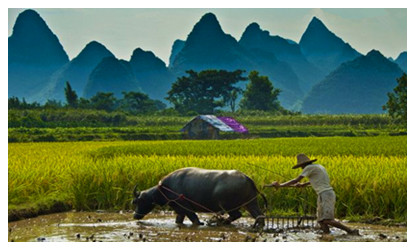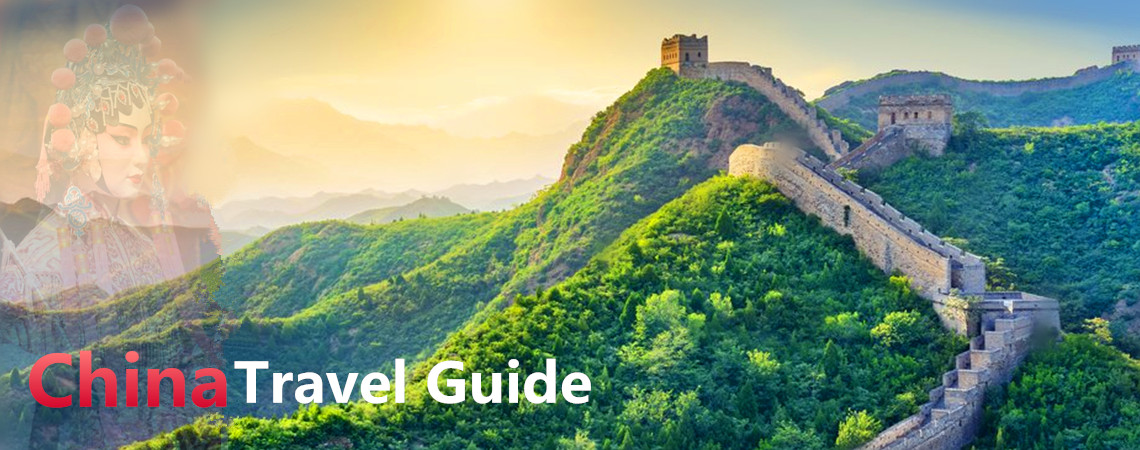China lies mainly in the northern temperate zone under the influence of monsoon.In China, a vast land spanning many degrees of latitude with complicated terrain, climate varies radically. China has a variety of temperature and rainfall zones, including continental monsoon areas.
China experiences a complex and varied climate. Most parts of the country lie in the northern temperature zone and subtropical zone and belong to the eastern Asia monsoon climatic area. China is a huge country with many different climates and types of landscape. Think of it in terms of the United States, which China resembles in size and shape.
Cold-Temperate Zone: north part of Heilongjiang Province and Inner Mongolia (Representative city: Harbin)
Mid-Temperate Zone: Jilin, northern Xinjiang, and most of Heilongjiang, Liaoning, and Inner Mongolia (Representative cities: Beijing, Shenyang, Dalian, Urumqi, Hohhot, Dunhuang, Lanzhou)
Warm-Temperate Zone: area of the middle and lower reaches of the Yellow River, Shandong, Shanxi, Shaanxi, and Hebei Province (Representative cities: Xian, Taiyuan, Luoyang, Jinan, Qingdao, Zhengzhou)
Subtropical Zone: South of isotherm of Qinling Mountain-Huaihe River, east of Qinghai-Tibet Plateau (Representative cities: Shanghai, Guangzhou, Hong Kong, Macau, Guilin, Hangzhou, Suzhou, Kunming, Dali, Lijiang, Chengdu)
Tropical Zone: Hainan province, southern Taiwan, Guangdong, and Yunnan Province (Representative cities: Haikou, Sanya)
Plateau Climate Zone: Qinghai-Tibet Plateau (Representative city: Lhasa)
China Climate by Region
China climates differ from region to region because of the country's extensive and complex topography. In the south of the Nanling Mountains, rains are prolific and the temperature is high all year round. In the Yangtze and Huaihe river valleys in the central part of China, there are four distinctive seasons.
In Northern China
In winter, from December to March, it can be extremely cold in northern China.
Beijing
may experience temperature of -20ºC at night, dry and no sun. Further north, -40ºC are not uncommon, and you'll see the curious sight of sand dunes covered in snow. In summer, from May to August, temperatures in
Beijing
can hit 38ºC (100ºF), coinciding with the rainy season for the city. In northeast China, summer is short but there is much sunshine, while winter is long and cold. The best time for visiting the north is spring and autumn. Daytime temperatures range from 20ºC to 30ºC ( 68-86ºF) and drop a lot at night. Precipitation is 6370cm (25-28 inches) per year.
In Central China
The Yangtze River valley has long and humid summer with high temperatures from April to October. The city of
Wuhan,
Chongqing
and
Nanjing
on the Yangtze are China's three famous 'furnaces'. In winter, with temperatures dropping well below freezing, it can be as cold as in
Beijing, particularly as there is no heating in public buildings to the south of the
Yangtze River. It can also be wet and miserable at any time apart from summer. Since it is impossible to choose an ideal time to visit, spring and autumn are probably best. Precipitation averages around 76 cm (30 inches) per year.
In South China
Near Guangzhou, the summer is a season of typhoons between July and September. Temperatures can rise to around 38C. Winters are short, between January and March. It's not as cold as in the north, but you'd better bring warm clothes with you while visiting. In southwest China of low latitudes, the land is elevated high, and has characteristically vertical seasonal zones. Autumn and spring can be good times to visit, with day temperatures in the 20ºC to 25ºC (68-75ºF) range. Sometimes, it can be miserably wet and cold, with rain or drizzle. Precipitation averages 76 cm (30 inches) per year.
In Northwest China
Precipitation is limited in northwest China where it is cold in winter and hot in summer.It gets hot in summer, dry and sunny. The desert regions can be scorching in the daytime. Turpan, which sits in a depression 150m below sea level, is referred to as the 'hottest place in China' with maximums of around 47ºC. In winter this region is as severely cold as the rest of northern China. Temperatures in Turphan during Winter are only slightly more favorable to human existence. This area of China climate experiences little rain, and as a consequence, the air is very dry. Summers, however, can exceed 40ºC, while winters may drop to -10ºC. Precipitation averages less than 10 cm (4 inches) per year.
In Tibet
Undoubtedly, Tibet is one of the harshest places for human existence. It is cool in summer but freezing cold in winter. In Lhasa, the mildest city in Tibet, temperature may exceed 29ºC in summer while plummeting to -16ºC in winter! Sun radiation is extremely strong in Tibet. The sunlight in Lhasa is so intense that the city is called Sunlight City. The thin air can neither block off nor retain heat so that the temperature extremes can be met in daytime and the same night respectively in Tibet. However it is not impossible to visit the holy snow land. April to October is the best time to visit Tibet, out of the coldest months, which are from December to February usually.
The average temperature in north Tibet is subzero and winter arrives in October until the following May or June. July and August are the best time to visit the area, enjoying warm temperature, intense sunshine, beautiful scenery and festive events. May, June and September is the tourist season in east Tibet. In winter, roads are all blocked by heavy snow. Landslides and rock falls frequently occur, which will make travel difficult.
South Tibet is balmy during May to October. During the period, there are also great festive events held. Hence it is the best time to visit Lhasa, Shigatse and Nyingchi. Most annual rainfall comes in the rainy season which starts from June to September. Usually it rains at night in Lhasa, Shigatse and Chamdo area. The rainfall may block roads and make travel difficult but the scenery at the time will be the best. From November to the coming May, the wind blows often.
China Weather by season
The Yangtze River serves as China's official dividing line between north and south. Given the size and varied landscape of the country, there is no one time in the year when weather is ideal in every part of China. Of course, the warmest areas in winter are to be found in the South and Southwest, such as Sichuan, Banna in Yunnan, and Hainan Island. In summer the coolest spots are in the far northeast. China has a climate dominated by dry seasons and wet monsoons, which leads to clear temperature differences in winter and summer. In winter, northern winds coming from high latitude areas are cold and dry; in summer, southern winds from sea areas at lower latitude are warm and moist.
In Spring
Spring in China is a season of recovery, commonly warm with a little rain. Spring can also be delightful with the average temperatures roughly the same as in autumn, at about 10° C - 22° C.
Clothing : Western suits, jackets, sports coats, woolen jackets, long sleeve shirts and travel shoes.
In Summer
In summer, the temperatures are high, it is the rainy season and temperature differences are small. However precipitation varies from 1,500 mm in the southeast to less than 50 mm in the northwest. The extremely high mountainous regions have constantly cold weather and the Qinghai-Tibet Plateau has a unique plateau climate, with a variety of mineral elements and abundant water resources. You can go to summer resorts in some northern cities of China. Summer is also the rainy season, so travelers should not forget umbrellas, light raincoats and rubber shoes.
Clothing: T-shirts, short sleeve shirts, skirts, sandals, caps, rain wear.
In Autumn
Autumn is a season which is suitable to visit any city of China. Normally, the most comfortable season of the year in China is early autumn (September to early October). During that period, temperatures are reasonable throughout China at about 10° C - 22° C with a limited amount of rain. Autumn is a harvest season. The sky is bright and clear. Your eyes are filled with the most beautiful view of the natural world.
Clothing: Western suits, jackets, sports coats, light woolen sweaters, rain wear and travel shoes
In Winter
In winter, the climate is cold and dry and the temperature difference between the south and the north can be forty degrees centigrade. In winter most areas become cold and dry. But off-season travel can also offer its rewards. For example, the Harbin Winter Ice Lantern Festival is a charming event. The southern China in winter is not that cold. However, the winter months are peak season for trips to China’s Hainan Island and to the Northeast Harbin for its world-famous ice-lantern festival. This months are also packed with New Year holidays, Chinese Spring Festival and other national or local happy fairs. Summer months are great time to explore China’s Far East-Manchuria.
Clothing: overcoat, cotton clothes, lined coats. In very cold areas a cap, gloves and cotton-padded shoes are required.
Best time to visit China

China can be visited through out the year because of the stretch of its territories and sites and activities it can offer.Deciding when to visit China depends on which places you wish to visit, what type of weather you enjoy, and how much a bargain you want.
April,May,September and October are the peak tourist months at China’s most popular destinations when the weather is the most comfortable. Prices drop a bit in the shoulder season, which runs from November through March and from June through August...
When to visit China? What to pack?
China Climate by Province
| Hebei Climate |
Guangdong Climate |
Hainan Climate |
Ningxia Cliamte |
| Henan Climate |
Jiangxi Cliamte |
Guizhou Climate |
Xinjiang Climate |
| Hubei Climate |
Anhui Climate |
Yunnan Climate |
Gansu Climate |
| Hunan Climate |
Jiangsu Climate |
SichuanClimate |
Shaanxi Climate |
| Tibet Climate |
Zhejiang Climate |
Qinghai Climate |
Inner Mongol Climate |
China Climate by City

 China can be visited through out the year because of the stretch of its territories and sites and activities it can offer.Deciding when to visit China depends on which places you wish to visit, what type of weather you enjoy, and how much a bargain you want.
China can be visited through out the year because of the stretch of its territories and sites and activities it can offer.Deciding when to visit China depends on which places you wish to visit, what type of weather you enjoy, and how much a bargain you want. Ask Questions ?
Ask Questions ?